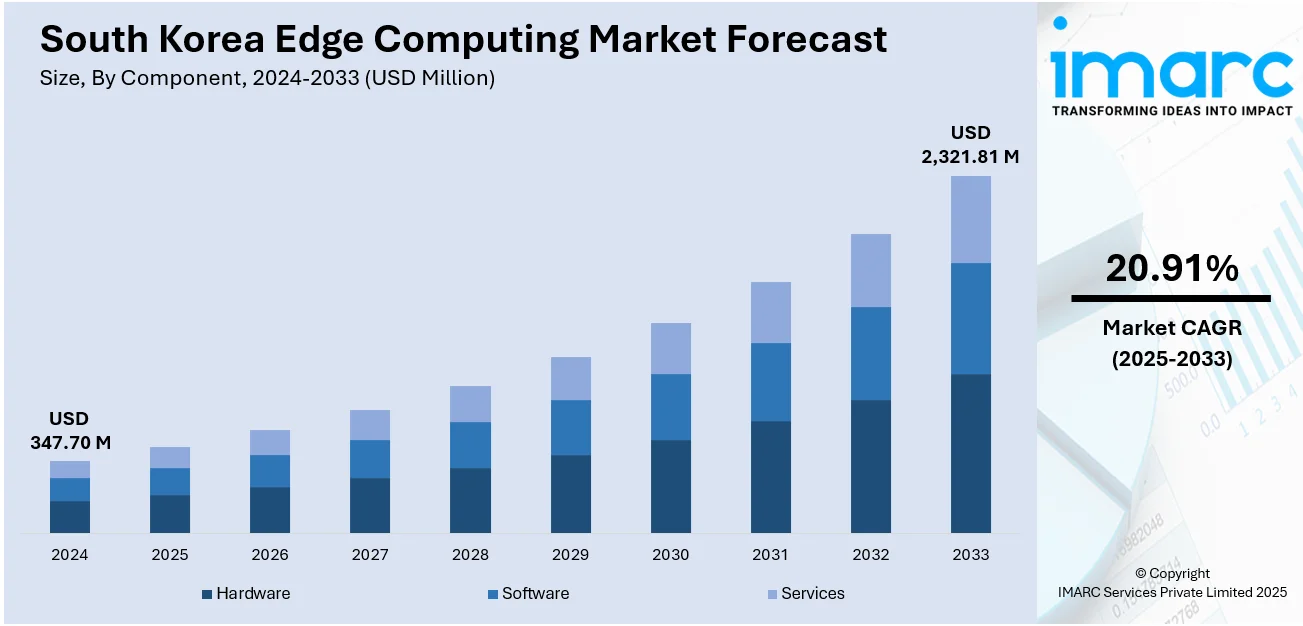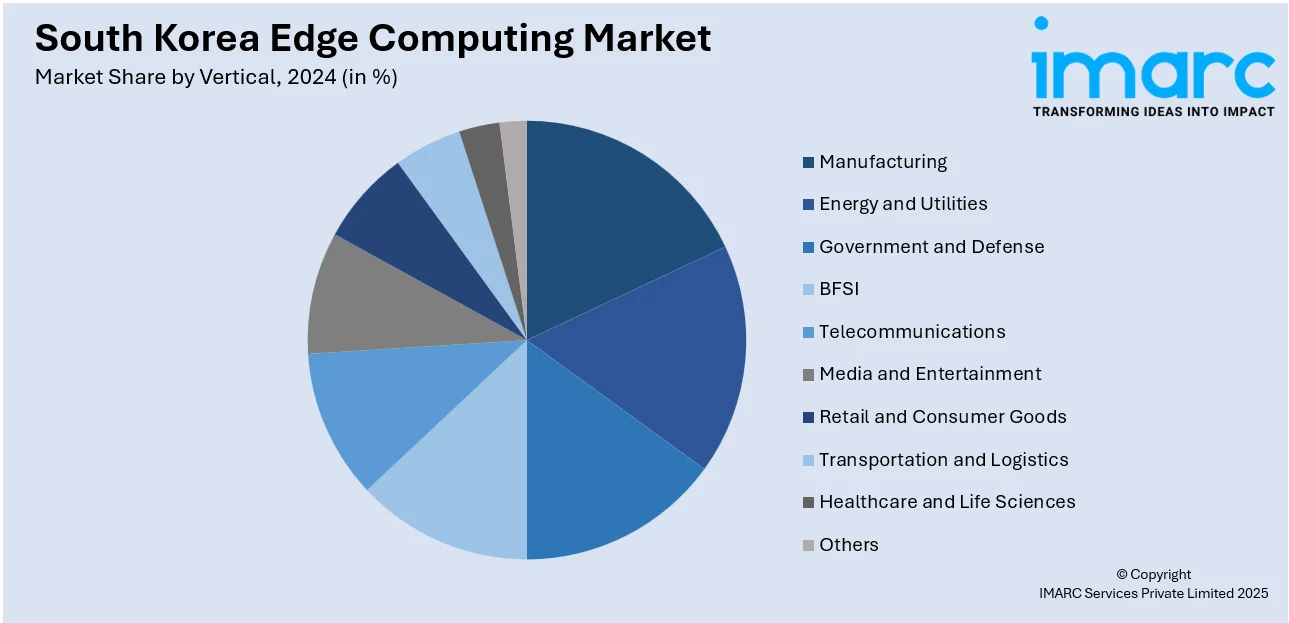
South Korea Edge Computing Market Size, Share, Trends and Forecast by Component, Organization Size, Vertical, and Region, 2025-2033
South Korea Edge Computing Market Overview:
The South Korea edge computing market size reached USD 347.70 Million in 2024. Looking forward, IMARC Group expects the market to reach USD 2,321.81 Million by 2033, exhibiting a growth rate (CAGR) of 20.91%during 2025-2033. The quick rollout of 5G networks in South Korea is one of the major drivers impelling the growth of the market. Moreover, Internet of Things (IoT) applications produce huge volumes of data that must be processed and analyzed in real-time to deliver optimal performance. Moreover, the South Korean government is actively promoting the digitalization of different industries, which is expanding the South Korea edge computing market share.
|
Report Attribute
|
Key Statistics
|
|---|---|
|
Base Year
|
2024
|
|
Forecast Years
|
2025-2033
|
|
Historical Years
|
2019-2024
|
| Market Size in 2024 | USD 347.70 Million |
| Market Forecast in 2033 | USD 2,321.81 Million |
| Market Growth Rate 2025-2033 | 20.91% |
South Korea Edge Computing Market Trends:
5G Network Rollout and Low Latency Demand
The quick rollout of 5G networks in South Korea is one of the major drivers of the market. Ultra-low latency, high bandwidth, and low-latency connectivity are offered by 5G technology, which are important for real-time data processing in use cases like autonomous vehicles, industrial automation, and augmented reality (AR). Edge computing, in bringing the computation nearer to the data source, assists in minimizing the latency in traditional cloud computing models. This complementarity of 5G capability and edge computing allows organizations to maximize performance, improve user experience, and facilitate real-time decision-making. Since South Korea is leading the world in 5G technology, the nation's investment in network infrastructure as well as edge computing solutions is speeding up the implementation of edge-based solutions in diverse sectors, such as healthcare, smart cities, and manufacturing. The average 5G transmission speeds of South Korea's top three mobile operators rose by 9.2% in 2024 compared to the prior year, greatly improving the caliber of 5G services, as stated in a report from the Korean government.

To get more information on this market, Request Sample
Increase in Internet of Things (IoT) Devices and Data-Driven Applications
Growing IoT devices in South Korea are playing a major role in impelling the South Korea edge computing market growth. IoT applications such as smart homes, smart factories, healthcare systems, and intelligent vehicles produce huge volumes of data that must be processed and analyzed in real-time to deliver optimal performance. With edge computing, data can be processed locally, offloading the workload from centralized cloud servers and enhancing response times. The urgency for real-time processing and decision-making of IoT applications is encouraging organizations to use edge computing solutions that facilitate quicker, more efficient operations. Given the tech-savvy nature of South Korea's population and its penchant for innovation, the spread of IoT devices further drives the need for local data processing, thereby pushing the market for edge computing forward.
Government Support and Digital Transformation Initiatives
The South Korean government is actively promoting the digitalization of different industries with a good business environment for embracing new technologies like edge computing. Policies by the government, including the "Digital New Deal" program, are intended to support the growth of smart technologies, artificial intelligence (AI), 5G, and data innovation. Under this initiative, the government is urging companies to upgrade their infrastructure, enhance data processing, and investigate novel business models that utilize edge computing for enhanced efficiency. Public sector initiatives like smart city construction and AI-based public services are also significantly dependent on edge computing solutions to handle enormous amounts of data in real-time. This backing propels the growth of the market by lowering hindrances to adoption, developing an environment that encourages mass assimilation of edge computing technologies in various sectors within South Korea. In 2025, the South Korean government is proceeding with a KRW27.3 billion ($19.9 million) initiative to establish micro data centers (MDCs) using domestically produced AI chips to support small and medium-sized enterprises (SMEs), hospitals, and public organizations. The plan is to increase the production of national AI chips, promote regional edge implementations of AI services, and assist the national SME sector.
South Korea Edge Computing Market Segmentation:
IMARC Group provides an analysis of the key trends in each segment of the market, along with forecasts at the country and regional levels for 2025-2033. Our report has categorized the market based on component, organization size, and vertical.
Component Insights:
- Hardware
- Software
- Services
The report has provided a detailed breakup and analysis of the market based on the component. This includes hardware, software, and services.
Organization Size Insights:
- Small and Medium-sized Enterprises (SMEs)
- Large Enterprises
A detailed breakup and analysis of the market based on the organization size have also been provided in the report. This includes small and medium-sized enterprises (SMEs) and large enterprises.
Vertical Insights:

- Manufacturing
- Energy and Utilities
- Government and Defense
- BFSI
- Telecommunications
- Media and Entertainment
- Retail and Consumer Goods
- Transportation and Logistics
- Healthcare and Life Sciences
- Others
The report has provided a detailed breakup and analysis of the market based on the vertical. This includes manufacturing, energy and utilities, government and defense, BFSI, telecommunications, media and entertainment, retail and consumer goods, transportation and logistics, healthcare and life sciences, and others.
Regional Insights:
- Seoul Capital Area
- Yeongnam (Southeastern Region)
- Honam (Southwestern Region)
- Hoseo (Central Region)
- Others
The report has also provided a comprehensive analysis of all the major regional markets, which include Seoul Capital Area, Yeongnam (Southeastern Region), Honam (Southwestern Region), Hoseo (Central Region), and others.
Competitive Landscape:
The market research report has also provided a comprehensive analysis of the competitive landscape. Competitive analysis such as market structure, key player positioning, top winning strategies, competitive dashboard, and company evaluation quadrant has been covered in the report. Also, detailed profiles of all major companies have been provided.
South Korea Edge Computing Market Report Coverage:
| Report Features | Details |
|---|---|
| Base Year of the Analysis | 2024 |
| Historical Period | 2019-2024 |
| Forecast Period | 2025-2033 |
| Units | Million USD |
| Scope of the Report |
Exploration of Historical Trends and Market Outlook, Industry Catalysts and Challenges, Segment-Wise Historical and Future Market Assessment:
|
| Components Covered | Hardware, Software, Services |
| Organization Sizes Covered | Small and Medium-sized Enterprises (SMEs), Large Enterprises |
| Verticals Covered | Manufacturing, Energy and Utilities, Government and Defense, BFSI, Telecommunications, Media and Entertainment, Retail and Consumer Goods, Transportation and Logistics, Healthcare and Life Sciences, Others |
| Regions Covered | Seoul Capital Area, Yeongnam (Southeastern Region), Honam (Southwestern Region), Hoseo (Central Region), Others |
| Customization Scope | 10% Free Customization |
| Post-Sale Analyst Support | 10-12 Weeks |
| Delivery Format | PDF and Excel through Email (We can also provide the editable version of the report in PPT/Word format on special request) |
Key Questions Answered in This Report:
- How has the South Korea edge computing market performed so far and how will it perform in the coming years?
- What is the breakup of the South Korea edge computing market on the basis of component?
- What is the breakup of the South Korea edge computing market on the basis of organization size?
- What is the breakup of the South Korea edge computing market on the basis of vertical?
- What is the breakup of the South Korea edge computing market on the basis of region?
- What are the various stages in the value chain of the South Korea edge computing market?
- What are the key driving factors and challenges in the South Korea edge computing market?
- What is the structure of the South Korea edge computing market and who are the key players?
- What is the degree of competition in the South Korea edge computing market?
Key Benefits for Stakeholders:
- IMARC’s industry report offers a comprehensive quantitative analysis of various market segments, historical and current market trends, market forecasts, and dynamics of the South Korea edge computing market from 2019-2033.
- The research report provides the latest information on the market drivers, challenges, and opportunities in the South Korea edge computing market.
- Porter's five forces analysis assist stakeholders in assessing the impact of new entrants, competitive rivalry, supplier power, buyer power, and the threat of substitution. It helps stakeholders to analyze the level of competition within the South Korea edge computing industry and its attractiveness.
- Competitive landscape allows stakeholders to understand their competitive environment and provides an insight into the current positions of key players in the market.
Need more help?
- Speak to our experienced analysts for insights on the current market scenarios.
- Include additional segments and countries to customize the report as per your requirement.
- Gain an unparalleled competitive advantage in your domain by understanding how to utilize the report and positively impacting your operations and revenue.
- For further assistance, please connect with our analysts.
 Request Customization
Request Customization
 Speak to an Analyst
Speak to an Analyst
 Request Brochure
Request Brochure
 Inquire Before Buying
Inquire Before Buying




.webp)




.webp)












